City Halls
Introduction
Text-to-speech Audio
The City Halls became the first performance venue for the public in Glasgow, a focus for events ranging from concerts to rallies and anti-slavery meetings. The venue helps illustrate Glasgow’s truly international contribution to universal emancipation. Frederick Douglass (1818-95) was an African American who, after escaping from slavery in Maryland in 1838, became a leading campaigner in the Foreign and American Anti-Slavery Society. After a series of lecture tours in the USA, Douglass spent two years on a circuit of churches, chapels and lectures throughout Great Britain and Ireland between 1846 and 1848.
Another example of Glasgow’s leading position in the global campaign for universal emancipation was the appearance of Harriet Beecher Stowe in 1853. Beecher Stowe (1811-96) was an American abolitionist and novelist, whose novel Uncle Tom’s Cabin, sold over 300,000 copies in the USA in the first year after it was published in 1852. Over half a million people signed the welcoming address to her lecture tour of Great Britain.
The Glasgow Emancipation Society started the Uncle Tom Offering, which was introduced to make up royalties Beecher Stowe could not receive in Britain. She appeared in Glasgow as a guest of the Glasgow Female New Association for the Abolition of Slavery. The same society hired a series of American Black abolitionist lecturers before and after Harriet’s visit, Those before included J.W. C. Pennington in 1849-51. A later guest of the same society was the Rev. Josiah Henson (1789-1883), a slave who had escaped to Canada in 1830 and was the inspiration for the fictitious ‘Uncle Tom’.
Images
Glasgow City Halls

Glasgow City Halls

